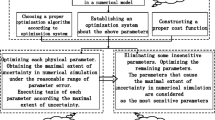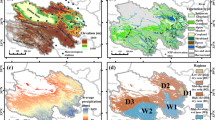Abstract
The approach of conditional nonlinear optimal perturbation related to parameter (CNOP-P) is employed to provide a possible climate scenario and to study the impact of climate change on the simulated net primary production (NPP) in China within a state-of-the-art Lund-Potsdam-Jena dynamic global vegetation model (LPJ DGVM). The CNOP-P, as a type of climate perturbation to bring variation in climatology and climate variability of the reference climate condition, causes the maximal impact on the simulated NPP in China. A linear climate perturbation that induces variation in climatology, as another possible climate scenario, is also applied to explore the role of variation in climate variability in the simulated NPP. It is shown that NPP decreases in northern China and increases in northeastern and southern China when the temperature changes as a result of a CNOP-P-type temperature change scenario. A similar magnitude of change in the spatial pattern variations of NPP is caused by the CNOP-P-type and the linear temperature change scenarios in northern and northeastern China, but not in southern China. The impact of the CNOP-P-type temperature change scenario on magnitude of change of NPP is more intense than that of the linear temperature change scenario. The numerical results also show that in southern China, the change in NPP caused by the CNOP-P-type temperature change scenario compared with the reference simulated NPP is sensitive. However, this sensitivity is not observed under the linear temperature change scenario. The seasonal simulations indicate that the differences between the variations in NPP due to the two types of temperature change scenarios principally stem from the variations in summer and autumn in southern China under the LPJ model. These numerical results imply that NPP is sensitive to the variation in temperature variability. The results influenced by the CNOP-P-type precipitation change scenario are similar to those under the linear precipitation change scenario, which cause the increasing NPP in arid and semi-arid regions of the northern China. The above findings indicate that the CNOP-P approach is a useful tool for exploring the nonlinear response of NPP to climate variability.



Similar content being viewed by others
Explore related subjects
Discover the latest articles and news from researchers in related subjects, suggested using machine learning.References
Beer C, Lucht W, Gerten D, Thonicke K, Schmullius C (2007) Effects of soil freezing and thawing on vegetation carbon density in Siberia: a modeling analysis with the Lund-Potsdam-Jena Dynamic Global Vegetation Model (LPJ-DGVM). Global Biogeochem Cycles 21:GB1012. doi:10.1029/2006GB002760
Berthelot M, Friedlingstein P, Ciais P, Dufresne JL, Monfray P (2005) How uncertainties in future climate change predictions translate into future terrestrial carbon fluxes. Glob Change Biol 11:959–970. doi:10.1111/j.1365-2486.2005.00957
Bonan GB, Levis S, Kergoat L, Oleson KW (2002) Land-scapes as patches of plant functional types: An integrated concept for climate and ecosystem models. Global Biogeochem Cycles 16(2):1021. doi:10.1029/2000GB001360
Botta A, Foley JA (2002) Effects of climate variability and disturbances on the Amazonian terrestrial ecosystems dynamics. Global Biogeochem Cycles 16(4):1070. doi:10.1029/2000GB001338
Braswell BH, Schimel DS, Linder E, Moore B III (1997) The response of global terrestrial ecosystems to interannual temperature variability. Science 278:870–872
Cao MK, Woodward FI (1998) Dynamic responses of terrestrial ecosystem carbon cycling to global climate change. Nature 393:249–252
Cao MK, Prince SD, Shugart HH (2002) Increasing terrestrial carbon uptake from the 1980s to the 1990s with changes in climate and atmospheric CO2. Global Biogeochem Cycles 16:1069. doi:10.1029/2001 GB001553
Cramer W et al (2001) Global response of terrestrial ecosystem structure and function to CO2 and climate change: results from six dynamic global vegetation models. Glob Chang Biol 7:357–373
Collins M, Booth BB, Harris GR, Murphy JM, Sexton DMH, Webb MJ (2006) Towards quantifying uncertainty in transient climate change. Clim Dyn 27:127–147. doi:10.1007/s00382-006-0121-0
Chakraborty UK (2008) Advances in differential evolution, 1rd ed., 340 pp., Springer Verlag, Heidelberg, Berlin
Duan Q, Gupta VK, Sorooshian S (1992) Effective and effcient global optimization for conceptual rainfall-runoff models. Water Resour Res 28:1015–1031
Fay PA, Kaufman DM, Nippert JB, Carlisle JD, Harper CW (2008) Changes in grassland ecosystem function due to extreme rainfall events: implications for responses to climate change. Glob Chang Biol 14:1600–1608
Field CB, Behrenfeld MJ, Randerson JT, Falkowski P (1998) Primary production of the biosphere: integrating terrestrialand oceanic components. Science 281:237–240
Fik TJ, Mulligan GF (1998) Functional form and spatial interaction models. Environ Plan A 30(8):1497–1507. doi:10.1068/a301497
Gao Q, Zhang X (1997) A simulation study of responses of the northeast China transect to elevated CO2 and climate change. Ecol Appl 7(2):470–483
Gao Q, Yu M (1998) A model of regional vegetation dynamics and its application to the study of Northeast China Transect (NECT) responses to global change. Global Biogeochem Cycles 12(2):329–344. doi:10.1029/97GB03659
Gao Q, Yu M, Yang X (2000) An analysis of sensitivity of terrestrial ecosystems of China to climatic change using spatial simulation. Climate Change 47:373–400
Gerber S, Joos F, Prentice IC (2004) Sensitivity of a dynamic global vegetation model to climate and atmospheric CO2. Glob Chang Biol 7:357–373
Hu ZZ, Yang S, Wu R (2003) Long-term climate variations in China and global warming signals. J Geophys Res 108(D19):4614. doi:10.1029/2003JD003651
IPCC (2007) Summary for policymakers. In: Climate change 2007: impacts, adaptation and vulnerability. Contribution of working group II to the fourth assessment report of the intergovernmental panel on climate change. Cambridge University Press: Cambridge, New York
Ji J, Huang M, Li K (2008) Prediction of carbon exchanges between China terrestrial ecosystem and atmosphere in 21st century. Sci China Ser D 51(6):885–898
Kharin VV, Zwiers FW, Zhang X, Hegerl GC (2007) Changes in temperature and precipitation extremes in the IPCC ensemble of global coupled model simulations. J Clim 20:1419–1444
Kicklighter DW et al (1999) A first-order analysis of the potential role of CO2 fertilization to affect the global carbon budget: a comparison of four terrestrial biosphere models. Tellus 51B:343–366
Kharin VV, Zwiers FW (2000) Changes in the extremes in an ensemble of transient climate simulations with a coupled atmosphere–ocean GCM. J Clim 13:3760–3788
Knapp AK, Smith MD (2001) Variation among biomes in temporal dynamics of aboveground primary production. Science 291:481–484
Kruger J (1993) Simulated annealing-a tool for data assimilation into an almost steady model state. J Phys Oceanogr 23(4):679–688
Lotsch A, Friedl MA, Anderson BT, Tucker CJ (2003) Coupled vegetation-precipitation variability observed from satellite and climate records. Geophys Res Lett 30(14):1774. doi:10.1029/2003GL017506
Matthews HD, Weaver AJ, Meissner KJ (2005) Terrestrial carbon cycle dynamics under recent and future climate change. J Clim 18:1609–1628
Medvigy D, Wofsy SC, Munger JW, Moorcroft PR (2010) Responses of terrestrial ecosystems and carbon budgets to current and future environmental variability. Proc Natl Acad Sci USA 107(18):8275–8280
Mitchell SW, Csillag F (2001) Assessing the stability and uncertainty of predicted vegetation growth under climatic variability: northern mixed grass prairie. Ecol Model 139:101–121
Mitchell TD, Jones PD (2005) An improved method of constructing a database of monthly climate observations and associated high-resolution grids. Int J Climatol 25(6):693–712
Mohamed MAA, Babiker IS, Chen ZM, Ikeda K, Ohta K, Kato K (2004) The role of climate variability in the inter-annual variation of terrestrial net primary production (NPP). Sci Total Environ 332:123–137
Mu M, Duan WS, Wang B (2003) Conditional nonlinear optimal perturbation and its applications. Nonlinear Processes Geophys 10:493–501
Mu M, Duan WS, Wang B (2007a) Season-dependent dynamics of nonlinear optimal error growth and El Nino- Southern oscillation predictability in a theoretical model. J Geophys Res 112, D10113. doi:10.1029/2005JD006981
Mu M, Wang HL, Zhou FF (2007b) A Preliminary application of conditional nonlinear optimal perturbation to adaptive observation. Chinese J Atmos Sci (inChinese) 31(6):1102–1112
Mu M, Wang B (2007) Nonlinear instability and sensitivity of a theoretical grassland ecosystem to finite-amplitude perturbations. Nonlin Processes Geophys 14:409–423
Mu M, Duan W, Wang Q, Zhang R (2010) An extension of conditional nonlinear optimal perturbation approach and its applications. Nonlin Processes Geophys 17:211–220. doi:10.5194/npg-17-211-2010
Ni J, Sykes MT, Prentice IC, Cramer W (2000) Modeling the vegetation of China using the process-based equilibrium terrestrial biosphere model BIOME3. Glob Ecol Biogeogr 9(6):463–479
Notaro M, Vavrus S, Liu Z (2007) Global vegetation and climate change due to future increases in CO2 as projected by a fully coupled model with dynamic vegetation. J Climate 20(1):70–90
Peng DL, Huang JF, Huete AR et al (2010) Spatial and seasonal characterization of net primary productivity and climate variables in southeastern China using MODIS data. J Zhejiang Univ-Sci B (Biomed Biotechnol) 11:275–285
Prentice IC, Cramer W, Harrison SP et al (1992) A global biome model based on plant physiology and dominance, soil properties and climate. J Biogeogr 19:117–134
Schaphoff S, Lucht W, Gerten D, Sitch S, Cramer W, Prentice IC (2006) Terrestrial biosphere carbon storage under alternative climate projections. Clim Chang 74(1–3):97–122. doi:10.1007/s10584-005-9002-5
Sitch S et al (2003) Evaluation of ecosystem dynamics, plant geography and terrestrial carbon cycling in the LPJ Dynamic Vegetation Model. Glob Chang Biol 9:161–185
Storn R, Price K (1997) Differential evolution—a simple and effcient heuristic for global optimization over continuous spaces. J Glob Optim 11:341–359
Sun G (2009) Simulation of Potential Vegetation Distribution and Estimation of Carbon Flux in China from 1981 to 1998 with LPJ Dynamic Global Vegetation Model[J]. Clim Environ Res(in Chinese) 14(4):341–351
Sun GD, Mu M (2009) Nonlinear feature of the abrupt transitions between multiple equilibria states of an ecosystem model. Adv Atmos Sci 26(2):293–304. doi:10.1007/s00376-009-0293-8
Sun G, Mu M (2011) Nonlinearly combined impacts of initial perturbation from human activities and parameter perturbation from climate change on the grassland ecosystem. Nonlin Processes Geophys 18:883–893. doi:10.5194/npg-18-883-2011
Sun GD, Mu M (2012) Responses of soil carbon variation to climate variability in China using the LPJ model. Theor Appl Climatol. doi:10.1007/s00704-012-0619-9
Tian H, Melillo JM, Kicklighter DW, McGuire AD, Helfrich JVK, Moore B, Vörösmarty CJ (1998) Effect of interannual climate variability on carbon storage in Amazonian ecosystems. Nature 396(6712):664–667
Wolf A, Blyth E, Harding R, Jacob D, Keup-Thiel E, Goettel H, Callaghan T (2008) Sensitivity of an ecosystem model to hydrology and temperature. Clim Chang 87:75–89
Wu S, Dai E, Huang M, Shao X, Li S, Tao B (2007) Ecosystem vulnerability of China under B2 climate scenario in the 21st century. Chin Sci Bull 52(10):1379–1386
Wu S, Yin Y, Zhao D, Huang M, Shao X, Dai E (2010) Impact of future climate change on terrestrial ecosystems in China. Int J Climatol 30:866–873
Zeng N, Ding Y, Pan J, Wang H, Gregg J (2008) Climate change: the Chinese challenge. Science 319:730–731
Zhang S, Zou X, Ahlquist J, Navon IM, Sela JG (2000) Use of differentiable and nondifferentiable optimization algorithms for variational data assimilation with discontinuous cost functions. Mon Weather Rev 128(12):4031–4044
Zhang X, Srinivasan R, Zhao K, Liew MV (2009) Evaluation of global optimization algorithms for parameter calibration of a computationally intensive hydrologic model. Hydrol Process 23:430–441
Zobler L (1986) A world soil file for global climate modelling, NASA Technical Memorandum, 87802, NASA, Washington, D.C., 32 pp
Zwiers FW, Kharin VV (1998) Changes in the extremes of the climate simulated by the CCC GCM2 under CO2 doubling. J Climate 11:2200–2222
Acknowledgments
The authors thank Prof. Weidong Guo for the valuable discussion and recommendation. Funding was provided by grants from LASG State Key Laboratory Special Fund and National Natural Science Foundation of China (No. 40905050, 40830955).
Author information
Authors and Affiliations
Corresponding author
Electronic supplementary material
Below is the link to the electronic supplementary material.
ESM 1
(DOC 1 mb)
Rights and permissions
About this article
Cite this article
Sun, G., Mu, M. Understanding variations and seasonal characteristics of net primary production under two types of climate change scenarios in China using the LPJ model. Climatic Change 120, 755–769 (2013). https://doi.org/10.1007/s10584-013-0833-1
Received:
Accepted:
Published:
Issue Date:
DOI: https://doi.org/10.1007/s10584-013-0833-1




